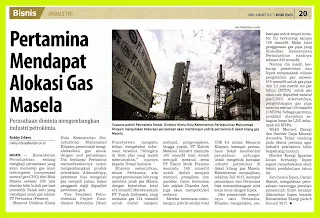BP Indonesia, operator of liquefied natural gas refinery in Bintuni Bay, West Papua, immediately take care refinery Train-2 April 2017. Head of Country BP Indonesia Dharmawan Samsu said, the current refinery has been operating in accordance with the capacity of 7.6 million tons per year (Mtpa).
The Company will conduct Train-2 treatment plant that does not produce liquefied natural gas / LNG for a while that from the beginning of April until the weekend second in May 2017. The refinery Care Train-1 was conducted in 2016.
Based on data from the work plan and budget (work plan and budget / WP & B), the volume of production ready for sale or lifting the gas from Block Berau, Muturi and Wiriager 1,303 million cubic feet per day (MMSCFD) in 2016
In 2017, gas lifting of the three oil and gas blocks it down to 986 MMSCFD with the maintenance activities of the 155 wells ready to sell gas production decrease was due to the low absorption of the needs of consumers as well as some unplanned shutdowns LNG plant.
"Checks and maintenance routines for LNG Train-2, which will start from the beginning of April until about the second week of May 2017," he said.
Care refinery should be performed every year alternately. Temporary suspension of production activities of the LNG plant, according to him, does not affect the production of, and commitment to the consumer.
Based on data from Special Unit of Upstream Oil and Gas (SKK Migas), the production of LNG in Indonesia this year were 163 278 freight cargo among others came from the Bontang LNG plant and 115 cargoes of LNG Tangguh.
"The process of checking and maintenance is already factored into the production plan Tough 2017 and will not interfere with our commitment to the LNG consumer."
In addition to refinery maintenance activity, the current refinery capacity expansion project goes according to set targets. Before starting the physical construction around the quarter III / 201 7, he said, BP is preparing a location while to disseminate to the surrounding community. With these activities, the project is expected to begin generating the first gas in 2020.
Tangguh LNG Project Train-3 is a phase of development in the form of one additional new LNG process facilities. Through the addition of the LNG processing facilities, there are additional production capacity of 3.8 Mtpa). In total, the refinery capacity to 11.4 Mtpa LNG from Train 1 and Train-2 that has been in operation since 2009. Apart from the addition of one LNG processing facilities, there are an additional 13 new production wells, two offshore platforms and new as LNG loading jetty ,
Darmawan explained, a process that also run concurrently namely drilling activities. Tangguh LNG Project Train-3 which requires an investment of US $ 8 billion, 75% of production of LNG will be sold to PLN.
IN INDONESIAN
Tangguh Train-2 Stop Sementara
BP Indonesia, operator kilang gas alam cair di Teluk Bintuni, Papua Barat, segera melakukan perawatan kilang Train-2 pada April 2017. Head of Country BP Indonesia Dharmawan Samsu mengatakan, saat ini kilang telah beroperasi sesuai dengan kapasitas 7,6 juta ton per tahun (Mtpa).
Perusahaan akan melakukan perawatan kilang Train-2 sehingga tidak menghasilkan gas alam cair/LNG untuk sementara yakni dari awal April hingga pekan kedua Mei 2017. Perawatan kilang Train-1 telah dilakukan pada 2016.
Berdasarkan data rencana kerja dan anggaran (work plan and budget/WP&B), volume produksi siap jual atau lifting gas yang berasal dari Blok Berau, Muturi, dan Wiriagar 1.303 juta kaki kubik per hari (MMSCFD) pada 2016
Pada 2017, lifting gas dari ketiga blok migas itu turun menjadi 986 MMscfd dengan kegiatan perawatan terhadap 155 sumur Penurunan produksi gas siap jual itu karena rendahnya penyerapan kebutuhan konsumen serta penghentian operasi terencana beberapa kilang LNG.
“Pengecekan dan perawatan rutin untuk LNG Train-2 yang akan dimulai dari awal April hingga sekitar minggu kedua Mei 2017,” ujarnya.
Perawatan kilang sudah lazim dilakukan setiap tahun secara bergantian. Penghentian sementara kegiatan produksi kilang LNG, menurutnya, tidak berpengaruh terhadap produksi serta komitmen terhadap konsumen.
Berdasarkan data Satuan Kerja Khusus Pelaksana Kegiatan Usaha Hulu Minyak dan Gas Bumi (SKK Migas), produksi LNG di Indonesia pada tahun ini 278 kargo yang 163 kargo antara lain berasal dari Kilang LNG Bontang dan 115 kargo dari Kilang LNG Tangguh.
“Proses pengecekan dan perawatan ini sudah diperhitungkan dalam rencana produksi Tangguh tahun 2017 dan tidak akan mengganggu komitmen terhadap konsumen LNG kami.”
Selain kegiatan perawatan kilang, saat ini proyek penambahan kapasitas kilang berjalan sesuai target yang telah ditetapkan. Sebelum memulai konstruksi fisik di sekitar kuartal III/ 201 7, dia menyebut, BP sedang menyiapkan lokasi sambil melakukan sosialisasi kepada masyarakat sekitar. Dengan kegiatan tersebut, proyek diharapkan mulai menghasilkan gas pertama pada 2020.
Proyek Kilang LNG Tangguh Train-3 merupakan fase pengembangan berupa tambahan satu fasilitas proses LNG baru. Melalui penambahan fasilitas pemroses LNG tersebut, terdapat tambahan kapasitas produksi 3,8 Mtpa). Secara total, kapasitas kilang LNG Tangguh menjadi 11,4 Mtpa dari Train-1 dan Train-2 yang sudah beroperasi sejak 2009. Selain tambahan satu fasilitas pemrosesan LNG, ada tambahan 13 sumur produksi baru, dua anjungan lepas pantai dan dermaga baru sebagai pemuatan LNG.
Dharmawan menjelaskan, proses yang juga berjalan bersamaan yakni kegiatan pengeboran sumur. Proyek Kilang LNG Tangguh Train-3 yang membutuhkan investasi US$8 miliar itu, 75% produksi LNG akan dijual kepada PLN.
Bisnis Indonesia, Page-30, Friday, March, 10, 2017










